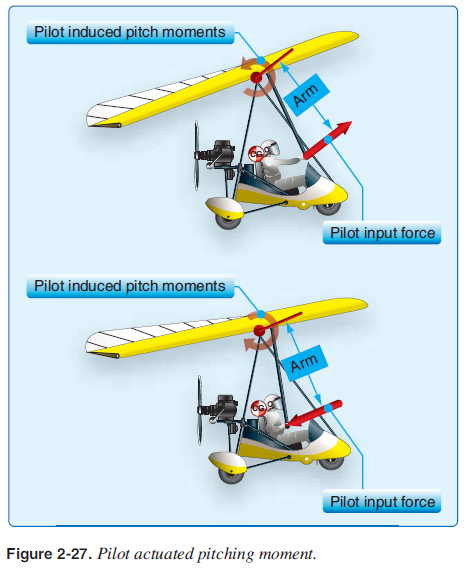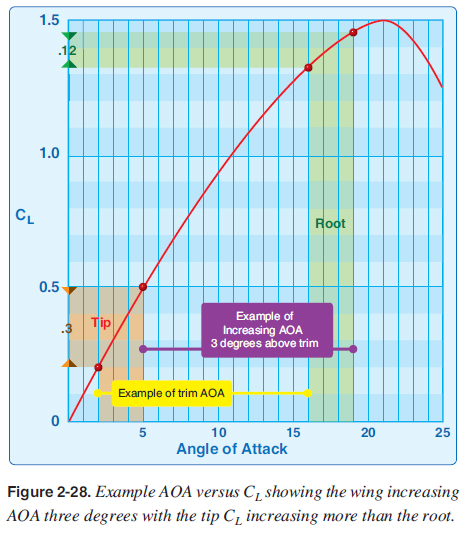
 |
|
||
CHAPTER 2. Aerodynamics Low Angles of Attack At very low AOA, the tip chords are near zero AOA or below, not producing any lift, as shown in Figure 2-25C. At this point, the nose area is producing all of the lift for the wing. The CLW moves forward a distance “c,” creating a positive stabilizing moment to raise the nose. Pitch Pressures As the pilot pushes out on the control bar, this creates a pilot input force that has a moment arm from the control bar up to the wing hang point. [Figure 2-27]  From this pilot-induced pitch moment, the control bar is pushed out, the nose raised, and the AOA increases an equal amount for both the root and the tip chords. However, as shown in Figures 2-26 and 2-28, the average CL change is greater at the low AOA at the tip chords, while the amount of change of the CL is much less at higher AOA at the root chord. Therefore, an increase in AOA for the wing results in the tips creating a greater proportion of the lift and moving the center of lift behind the CG, creating a negative pitching moment to lower the nose at high AOA.  Based on the same principle, when the wing AOA is lowered below the trim position, the tip chords’ CL decreases more than the root chord and the center of lift for the wing moves forward creating a positive moment to raise the nose at lower AOA. In situations where the pilot is fl ying in severe/extreme turbulence, wind sheer, or the pilot is exceeding the limitations of the aircraft, the WSC aircraft can get into a situation where the root chord is at a negative AOA and not producing lift. This could result in an emergency vertical dive situation, as discussed later in the Whip Stall-Tuck-Tumble section. When at very low angles or negative angles of attack, the WSC wing is designed so that the wing has positive stability or a noseup aerodynamic moment. This is accomplished by a number of different systems (washout struts, sprogs and refl ex lines) further explained in chapter 3 that simply keep the trailing edge of the wing up in an emergency low/negative AOA dive situation. As shown in Figure 2-29, the root area of the wing has refl ex which creates a positive pitching moment for the root chord to rotate the nose up towards a level fl ying attitude. At the same time, the tips are at a negative AOA producing lift in the opposite direction as usual, creating a moment to bring the nose/root chord up to a positive AOA to start producing lift and raising the nose to a normal fl ight condition. The negative lift or downward force as produced at the tips and root as shown provide a positive moment to raise the nose back to a normal fl ying attitude.  Refl ex also provides a stable pitch up moment for an airfoil when it is fl ying at normal fl ight angles of attack. The greater the refl ex, the greater the nose up moment of the airfoil. This is used in some WSC airfoil designs and also for trim control as discussed in Chapter 3. Carriage Moments The wing design is the main contributing factor for pitch stability and moments, but the carriage design can also infl uence the pitching moment of the WSC aircraft. For example, at very high speeds in a dive, a streamlined carriage would have less drag and, therefore, a greater nose-up moment because of less drag. The design of the carriage parts can have an effect on aerodynamic forces on the carriage, resulting in different moments for different carriage designs. The drag of the wing in combination with the drag of the carriage at various airspeeds provides a number of pitching moments, which are tested by the manufacturer—a reason the carriage is matched to the wing for compatibility. Each manufacturer designs the carriage to match the wing and takes into account these unique factors. Pitch Moments Summary Overall, the amount of sweep, twist, specifi c airfoil design from root to the tip, and the carriage design determine the pitching moments of the WSC aircraft. Some have small pitching moments, some have greater pitching moments. Each WSC model is different with a balance of these aerodynamic parameters to accomplish the specifi c mission for each unique carriage and wing combination. |
| ©AvStop Online Magazine Contact Us Return To Books |